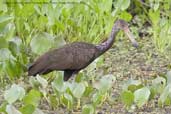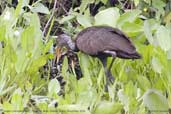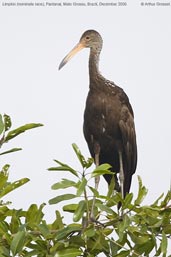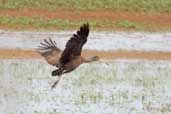Brazilian name: carão

Brazil
The Limpkin is in a family of its own and it is still uncertain exactly how it relates to other birds. It shows some affinity with cranes (there are no cranes in South America) and rails while recent DNA tests suggest that it may be more closely related to finfoots such as the Sungrebe Heliornis fulica.

The painting by Audubon of the Florida Limpkin in his 1840 "Birds of America" seems to be of the South American species!

The spread of non-native plants throughout much of its range may well affect the survival of the apple snail and hence of the Limpkin and the Snail Kite Rostrhamus sociabilis which also feeds largely on these snails.
The Limpkin and the Snail Kite have
different techniques for eating the apple snails. The Limpkin
places the snail firmly on the mud and hammers it with its bill.
It then lifts the snail, tosses it in the air, catches and
swallows the meat while letting the shell fall to the ground.

The Limpkin has a loud call and in Amazonia
the locals say that, when the Limpkin starts to call the rivers
will stop rising.
There are recordings and a distribution map on xeno-canto.
| Previous Page | Back to Index | Next Page |